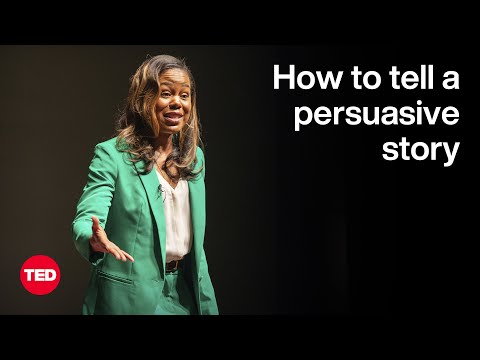In today’s fast-paced world, being able to communicate effectively is your ticket to standing out, whether you’re an aspiring speaker or a seasoned entrepreneur. The persuasive TED Talk has emerged as a dynamic tool that captivates global audiences, providing immense opportunities for those who master it. Here, we’re diving deep into the secrets of crafting a persuasive TED Talk that’ll resonate with your listeners, while also giving you some actionable tips drawn from proven speakers who know how to nail it.

Top 7 Secrets of Persuasive TED Talks That Captivate
Crafting a captivating TED Talk isn’t just an art; it’s about harnessing the power of persuasive rhetoric and the techniques of public speaking. Here are seven secrets that can transform your presentation from bland to magnetic:

The Power of Persuasive Rhetoric in TED Talks
The effectiveness of persuasive rhetoric goes beyond mere skill—it’s an essential tool for impactful communication. It combines the right word choices, a compelling structure, and the ability to resonate on emotional and intellectual levels. Great TED speakers weave ethos (credibility), pathos (emotion), and logos (logic) into their narratives seamlessly.
With technological advancements, content consumption has transformed; platforms like YouTube allow powerful talks to go viral. Think about Jordan Peterson’s “The Psychology of Personality,” where he fuses psychological insights with personal anecdotes. His ability to provoke thought and foster engagement has led many of his talks to trend globally, underscoring the powerful influence of persuasive rhetoric today.

Mastering the Art of Persuasive Writing and Public Speaking
Delivering a persuasive TED Talk is just one piece of the puzzle. To truly make an impact, mastering the art of persuasive writing and public speaking is crucial. This involves fine-tuning how you structure arguments, refining your pacing, and nailing the non-verbal cues.
Take inspiration from Tony Robbins. His dynamic movements and vocal variety not only command attention but also drive home his key messages about personal empowerment. This demonstrates how physical presence and vocal delivery can significantly enhance your persuasive capabilities.

Innovative Wrap-Up: Your Call to Captivation
If you’re eager to engage your audience with a persuasive TED Talk, embrace the combination of elements we discussed: storytelling, authenticity, visuals—everything works together. Study great speakers; extract their lessons while honing your own voice. Experiment with these tactics consistently and gather feedback.
Each stumble on stage is just part of your journey towards mastery. Immerse yourself in challenges, for they propel you toward brilliance. It’s time to empower yourself; don’t just speak—move, inspire, and create change with your message. The world is waiting for your unique voice to rise up and make a difference—so go on, make it count!
Ultimately, the journey into mastering persuasive speaking isn’t simply a professional endeavor; it’s a chance to impact lives, shift perspectives, and bring people along for the ride of realization and enlightenment. After all, isn’t that what life is all about? A persuasive TED Talk can be your stepping stone into that narrative.
For additional resources to help you on your speaking journey, check out the best Ted talk Speeches and some tips on effective presentation. And never underestimate the power of good persuasive rhetoric—it’s what distinguishes great speakers from good ones.

Persuasive TED Talk Secrets to Captivating Your Audience
The Power of Persuasion
When it comes to delivering a persuasive TED Talk, engaging your audience is key. Did you know that great speakers often use the eye zoom in technique? This approach allows speakers to highlight important points and draw the audience’s attention directly where it needs to be. It’s all about making that personal connection, just as the “Schitt’s Creek meme” captures a poignant moment in comedy, evoking emotions that keep audiences hooked. The real magic happens when speakers blend storytelling with compelling visuals, elevating their message and creating an unforgettable experience.
Humor and Relatability
Humor can be a secret weapon too! Just like the charming coastal town of “Rockport, Massachusetts,” which enchants visitors with its whimsical vibe, incorporating light-hearted moments can warm up the atmosphere. A well-timed joke or a funny story can break the ice, making your audience feel at ease and more receptive to your message. It’s similar to dodging cliches: bringing something fresh keeps listeners engaged and energized. You wouldn’t want to sound like you’re reciting the best Cliches from a dusty book when you can bring your own flair into the mix.
Connection and Depth
To truly captivate an audience, speaking from the heart is essential. That’s where relatable anecdotes come in, and shows like Professor T Season 2 illustrate how personal stories can resonate deeply and provoke thought. By weaving in real experiences, you allow your listeners to gain insight and feel connected to your journey. It’s like giving them a wide berth to explore alongside you, creating a comfortable space for dialogue. So, grab the audience’s attention with your authentic self, because viewers crave transparency and sincerity.
By incorporating these engaging elements, you can enhance the effectiveness of your persuasive TED Talk. In a world that’s getting more crowded with messages, an earnest and entertaining approach builds bridges that can transform mere audiences into devoted followers. Remember, it’s all about creating those deeper connections through relatable storytelling—just ask Michael Tell, who showcases the importance of being genuine in every performance!

How to write a persuasive TED Talk?
To write a persuasive TED Talk, start by connecting with your audience on a topic they care about. Clearly state your idea early on and make it relatable, even if it’s in a niche field. Build your argument with strong points backed by knowledge, while also acknowledging and addressing potential counter-arguments to make your case more compelling.
What are the 10 most popular Ted talks?
Some of the most popular TED Talks include “Do Schools Kill Creativity?” by Sir Ken Robinson, “Your Body Language May Shape Who You Are” by Amy Cuddy, and “How Great Leaders Inspire Action” by Simon Sinek. These talks resonate deeply and often provoke thought and discussions.
What is the best persuasive speech?
The best persuasive speech effectively convinces the audience about a specific viewpoint through clear arguments, emotional appeal, and credible evidence, creating a strong connection that motivates change or action.
Are TED talks meant to be persuasive?
Yes, TED Talks are meant to be persuasive. They’re designed to share ideas worth spreading, and persuasive elements are essential in influencing the audience’s thoughts and actions.
What is a good example of a persuasive message?
A good example of a persuasive message might be advocating for renewable energy usage by highlighting environmental impacts, cost savings, and the benefits of sustainability, stirring feelings of hope and responsibility.
What does TED stand for?
TED stands for Technology, Entertainment, and Design, reflecting the original focus of the talks, though they’ve since broadened to include a wide range of topics.
What is the most clicked TED talk?
The most clicked TED Talk is “Your Body Language May Shape Who You Are” by Amy Cuddy, as it’s been viewed millions of times and sparked widespread interest in the impact of body language on how we perceive ourselves.
Can anyone do a TED talk?
Yes, anyone can do a TED Talk, as long as they have a compelling idea to share. However, it’s essential to apply through local TEDx events, which are independently organized.
How do I find a good TED talk topic?
Finding a good TED Talk topic often starts with what you’re passionate about. Consider what knowledge you’ll be excited to share and how it can connect with a wider audience or address a current issue.
What are 5 examples of persuasive speech?
Five examples of persuasive speeches include advocating for climate action, promoting a healthier lifestyle, discussing the importance of mental health awareness, encouraging community service, and pushing for educational reform.
How do I choose a persuasive topic?
To choose a persuasive topic, consider what’s relevant to your audience, what you’re knowledgeable about, and what stirs your passion. Focus on issues that spark interest and have clear pros and cons to discuss.
What is the easiest persuasive speech topic?
Easy persuasive speech topics could include why everyone should recycle, the benefits of regular exercise, or the importance of reading daily. These are relatable and straightforward for a wide audience.
Why are TED talks only 18 minutes?
TED Talks are only 18 minutes long because it’s been found that this length is optimal for keeping an audience’s attention while allowing enough time for a clear and impactful message.
What’s the difference between a TED talk and a TED talk?
The difference between a TED Talk and a TEDx Talk lies in their scope. TED Talks are given at larger, official TED events, while TEDx Talks are independently organized events that follow the TED format and guidelines.
Do people memorize TED talks?
Many speakers don’t memorize TED Talks word for word; instead, they often rehearse key points and practice delivering them naturally to maintain a genuine connection with the audience.
How do you start a persuasive talk?
Starting a persuasive talk can be done by posing a thought-provoking question, sharing a startling statistic, or telling a relatable story that draws the audience in and sets the stage for your argument.
How do you write an effective TED talk?
Writing an effective TED Talk involves structuring your content clearly, using engaging storytelling, and focusing on your core idea, making sure every part contributes to your overall message.
What is the format for a TED talk?
A common format for a TED Talk includes an engaging introduction, a well-structured body with clear points, and a strong conclusion that reinforces your message and inspires action or thought.
What are good persuasive sentence starters?
Good persuasive sentence starters include phrases like “Imagine if…,” “Have you ever wondered…,” or “It’s crucial that we…,” which capture attention and set a persuasive tone.









